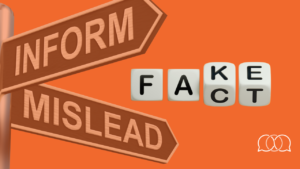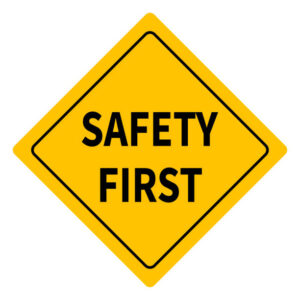In today’s digital jungle, “seeing is believing” just doesn’t cut it anymore. Between fake news, deepfakes, and filter bubbles, today’s students need to be more than just internet-savvy—they need full-blown digital literacy superpowers! Thankfully, digital literacy isn’t just a lesson—it’s a survival skill, and Mike Ribble’s 9 Elements of Digital Citizenship provide a brilliant framework to help students navigate this information maze. Here’s how we’re using Ribble’s elements to teach students to separate fact from fiction in the world of misinformation.
The Deepfake Dilemma: Questioning What We See and Hear
In the video Can We Still Trust What We See and Hear?, students are introduced to the complex world of fake news and deepfakes. From the propaganda of ancient Rome to AI-powered hoaxes, the video shows that misinformation isn’t a new game—only the players have changed. Deepfakes, in particular, use AI to create ultra-realistic fake videos and audio that can fool even the most discerning viewers. The CBC article highlights the harm these deepfakes can cause, from financial scams to emotional manipulation, underscoring the urgent need for digital literacy skills.

Here’s where Ribble’s Digital Fluency comes into play. This element is all about teaching students to evaluate information critically, including visual and audio content. As students learn to analyze what they’re seeing and hearing, they’re developing a healthy digital skepticism—one that will serve them well as they navigate an online world where not everything is what it seems.
Takeaway: Teach students that a little skepticism is their best defense. If something looks too real (or too wild) to be true, it just might be!

Combating Fake News: Media Literacy for the Modern Age
When it comes to spotting fake news, students need to be more than just skeptical—they need to know how to dig deeper. The article Strengthen Media Literacy to Win the Fight Against Misinformation discusses the proactive approach some countries are taking to teach students how to recognize and resist misinformation. Countries like Sweden and Finland are leading the way with robust media literacy programs that empower students to analyze information and spot misleading narratives. Chris Brennan’s video Fake News and How We Combat It echoes this, advocating for media literacy as a vital tool against fake news.

Ribble’s Digital Literacy element is key here, teaching students the skills to critically evaluate online information. This means understanding who created a piece of content, what their intentions might be, and whether the source is credible. With the flood of information on their feeds, students who understand digital literacy can spot the truth—and call out the fakes.
Classroom Tip: Try a “real or fake” game, where students evaluate headlines and images, using tools and strategies to separate credible news from clickbait.
Biases and Bubbles: Breaking Out of the Echo Chamber
Fake news doesn’t thrive just because it’s easy to believe—it’s also tailor-made for each of us, thanks to our own biases and filter bubbles. The article on cognitive biases and filter bubbles explains how confirmation bias leads people to believe what they already agree with, while filter bubbles make it seem like everyone shares our worldview. These mental traps make it even harder to distinguish truth from fiction.
Ribble’s Digital Etiquette and Digital Rights & Responsibilities elements help address this by teaching students to respect diverse viewpoints and engage thoughtfully online. This means stepping out of their bubbles, considering different perspectives, and challenging their own biases. Understanding how algorithms and filters shape what they see is a critical part of digital literacy—one that helps students question not just the content they see, but also why they’re seeing it.
Classroom Activity: Have students explore the same news topic on different platforms and see how coverage changes. Then, discuss how different angles shape perceptions.
Safety First: Protecting Ourselves and Others Online

Beyond recognizing fake content, students need to understand the personal and societal risks of misinformation. Ribble’s Digital Security element emphasizes the importance of knowing how to protect oneself from the darker side of digital interactions, from online scams to privacy breaches. For example, scammers often use deepfake technology to create “proof” of events or situations that never happened, tricking people into giving away money or personal information.
Pro Tip: Teach students to take a step back and verify sources before clicking or sharing. A little caution can go a long way in avoiding online traps.
Digital Citizenship is a Team Sport: Empathy, Respect, and Social Responsibility
In a world where everyone has a platform, students need to understand that their digital actions matter. Ribble’s Digital Communication and Digital Law elements encourage students to engage respectfully and responsibly, even when they disagree. By teaching students to uphold digital citizenship values, we’re not just preparing them to recognize fake news or avoid scams—we’re encouraging them to be thoughtful, ethical participants in the digital world.
Ribble’s Digital Health and Wellness also reminds students of the mental and emotional impacts of constant media consumption. After all, spending hours in an echo chamber can be exhausting and confusing. Teaching students to balance their screen time and engage with information responsibly can help them stay grounded amidst the noise.
Final Thought: If we want students to thrive in today’s digital world, they need more than a “don’t believe everything you see” lesson. Ribble’s 9 Elements give them the skills to be critical, cautious, and compassionate digital citizens.
Conclusion: From Passive Scrollers to Savvy Surfers
Teaching digital citizenship is about more than just survival—it’s about empowering students to question, evaluate, and engage meaningfully online. By using Ribble’s 9 Elements, we’re equipping them with the tools to spot misinformation, avoid digital pitfalls, and even challenge their own biases. So here’s to the next generation of savvy digital citizens—may they scroll wisely, share responsibly, and always keep a critical eye on the screen.

2 Comments
Ayodele
Hi Allysia
Thanks for the detailed post. Your indication of Digital Jungle really made me smile. Yes, fake News and Deepfake news are very pervasive in today’s digital world, and this trend has even become more complex due to the filter bubble algorithms that keep isolating an individual from other information due to the personal searches conducted or recent sites visited. I usually see certain news posts/alerts on my phone, and I wonder how these kinds of news keep popping up on my phone. However, the last lecture enhanced my knowledge of filter bubbles and how they come into play. I also love the way you integrated and explained how Ribbel’s digital framework can be used to assist students in unpacking misinformation and keeping their mental health in today’s Digital jungle.
Allysia Doratti
Hi there!
Thank you so much for your thoughtful response! I’m glad “Digital Jungle” resonated with you—it really does feel like navigating through vines of fake news, deepfakes, and those persistent filter bubbles! It’s amazing how algorithms can shape our digital experience so subtly, often without us realizing. I completely relate to seeing certain news alerts that seem to follow us around, and it’s eye-opening to learn how these filter bubbles actually work to isolate us from diverse perspectives.
I’m thrilled that Ribble’s digital framework stood out for you too. It’s such a powerful tool for helping students critically assess the information they encounter and guard their mental health amid the noise. Knowing we can equip them to see through the “jungle” is so rewarding. Thanks again for your insights—they add so much depth to this conversation!